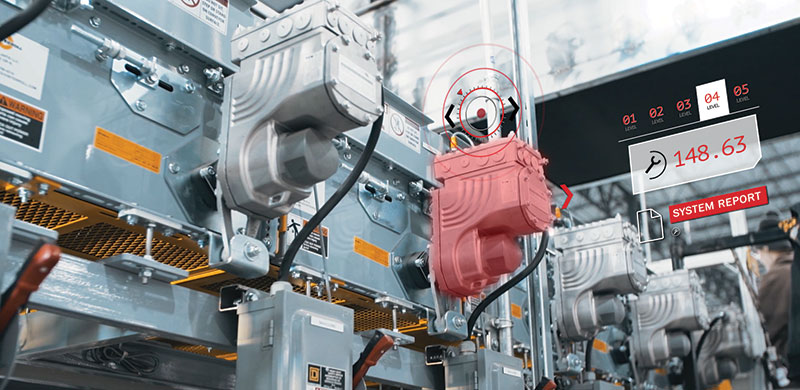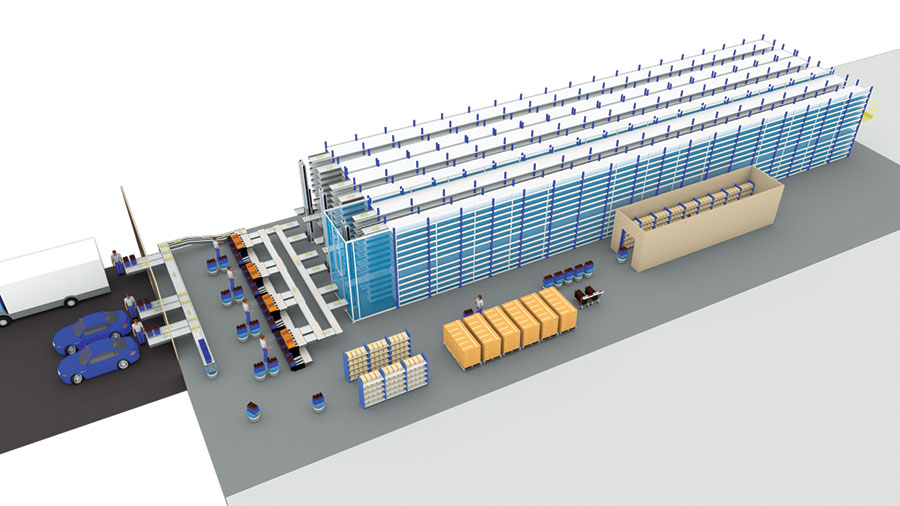MRO: Planning for peak demand season
There’s no time quite like peak, regardless of how long it lasts. Upfront maintenance planning is essential to making it through with as little downtime as possible. And so is ownership of the challenge by your tech teams to keep all equipment—from lift trucks to automated systems—humming when the orders never seem to stop.
Everyone knows forecasts are always wrong, however… When it comes to peak periods, a wrong forecast is not nearly as debilitating as a maintenance failure that shuts down equipment for any period of time. Whether peak is a few months, weeks or days, maintenance has to be up to date and out of the way of operations for the duration, regardless of the forecast’s precision. Crunch time is crunch time.
That’s easier said than done. Being out of the way doesn’t just happen. It takes planning and quite a bit of it. Just ask Brian Poveromo, senior facility and maintenance manager at American Eagle Outfitter’s 1.6-million-square-foot distribution center in Hazelton, Pa.
He’s been through seven holiday peaks in that facility and enjoys 99.99% uptime across that time. “We’ve never had a major piece of equipment go down during peak,” Poveromo says. Then again, his team started planning for such success days after the previous year’s peak ended in January. By September, they were into the details of preparing all equipment for peak usage levels. And then the orders started dropping in October.
Several paths can lead you to American Eagle-like success. Some maintenance teams can carry the load themselves. Others share it with service suppliers, often from the equipment supplier or lift truck dealer. Some turn it all over to a service supplier. All are viable routes. And, they all have one attribute in common: fanatical planning. Here are some tips from the experts.
Start with an assessment
To begin, right now is prime time for planning for peak for the coming holiday season. However, not everyone actually does proper planning.
“About 30% of facilities aren’t proactive. They even push back on the very idea of planning,” says Rod Payne, regional parts service manager for Raymond dealer Associated. That can be a problem when your business can least afford it.
Another common mistake is thinking that this is just about maintenance. It’s not. “Planning for peak is an entire facility activity,” explains Derek Lang, Swisslog’s vice president of customer service.
He goes on to say that maintenance needs to work with operations as well as IT and even top management to ensure the right steps are taken up front. “We’re all preparing for game day when operations is processing a steadily swelling order profile for both brick-and-mortar and e-commerce orders leading up to the end of December,” says Lang.
Without doubt, the swing to peak is brutal. For instance, e-commerce orders that are often 25% or 50% of capacity most of the year suddenly swing to 300% to 400% at peak, explains Lang speaking about his days at Target.
The first step typically occurred months earlier, explains Dave Trice, vice president of business development for lifecycle performance services at MHS. That’s when the maintenance team reviews how they had survived the previous peak season with a list of what went well and what could use improvement.
Trice strongly advocates a full performance assessment of materials handling equipment several weeks in front of peak. It’s a review of the equipment and its performance of designated processes. This is also the time to identify high-risk situations in the next peak period.
He also recommends that an outside service supplier either entirely conducts the assessment or work with the staff maintenance team. “It’s another set of eyes and a different perspective that can provide valuable insights that will save heartache during peak,” says Tice.
An important aspect of the assessment is to determine what maintenance activities need to be done before peak starts to get through the surge, explains John Daugherty, director of OSD analytics and simulation at Honeywell Intelligrated. Starting early enough ensures you have time to perform all needed preventative maintenance before peak.
Data is essential here, explains Kim Stachler, Crown’s marketing connected product manager. “Having the right data and enough of it sets the planning baseline for equipment performance during peak. With lift trucks in particular, usage data provides a great window into what needs to be maintained prior to peak. It also highlights potential issues during peak,” she adds.

Predictive maintenance practices require some fine tuning to accommodate peak periods.
Lift truck usage data, especially from on-board telematics, offers key insights into whether the equipment has been over- or under-utilized going into peak, says John Rosenberger, director of iWarehouse Gateway and global telematics at The Raymond Corp. That information can then be translated into a maintenance schedule for individual lift trucks, allowing equipment rotation that does not interfere with peak throughput, he adds.
There is also a forecast angle here, says Daugherty. Quite simply, is the system capable of handling the forecast throughput? Simulation, he adds, can be a strong predictive tool of the system’s capacity.
“A full system discrete simulation can run dozens or even hundreds of scenarios on the system’s capacity both in its current state and should a breakdown occur,” says Daugherty. “Simulation offers backup processing scenarios as well as a gauge of the impact of a breakdown on order fulfillment capabilities when time is of the essence,” he adds.
Which brings up a point all the experts interviewed for this article agree. Plan for Murphy, as Poveromo puts it.
A primary purpose of peak planning is to ensure maintenance is prepared for a breakdown. The idea is to reduce downtime as much as possible by knowing what the techs will do if something untoward happens. “Being prepared saved us multiple times,” says Poveromo of American Eagle.
“To assure high system uptime, replacement parts inventory must be fully stocked with the appropriate quantities,” says Ken Ruehrdanz, manager of distribution systems market at Dematic. Ruehrdanz and others cite a computerized maintenance management system (CMMS) as a key component. Its value is the ability to both maintain parts inventory and automatically order and re-order replacement parts.
Yes, says Trice of MHS, you want just enough spare parts inventory on hand. And, you don’t have to be fully stocked either, says Payne of Associated. Both say that dealers and equipment suppliers alike can be powerful allies here. They recommend partnering with such resources so replacement parts are stocked, ready for an emergency.
There’s also the matter of the move to predictive maintenance. Most everything discussed so far has been based on preventative and some usage-based maintenance schedules. However, predictive maintenance, which companies are clearly moving to, is based on actual need based on data. Clearly, that leaves the door open to untimely repairs during peak. How can you deal with that?
“You live in a reality that is multi-dimensional,” says Crown’s Stachler. “Pure predictive might be the best way to go during non-peak times. But it’s probably best to blend that with a preventative mind set when it comes to peak,” she adds. The challenge is to find the best mix of the two, using a postmortem after peak to assess the effectiveness of the approach and its various components.

Simulation offers backup order processing scenarios before a breakdown occurs.
The people side of peak
Maintenance planning for peak is just as much a people issue as it is an equipment issue, explains Poveromo.
Or as Swisslog’s Lang puts it, “planning for peak is a study of both human nature and maintenance practices.” He and others used the word “ownership” often to describe the basis for success. And ownership extends from development of a team mentality down to which individuals have responsibility for each piece of equipment and specific maintenance tasks.
Team mentality starts at the top with DC management. “Executives can’t assume that the peak preparedness just materializes and all the right people are in place,” says Daugherty of Honeywell Intelligrated. “They should be involved and visible. And there’s nothing wrong with them leading a pep rally to build peak team ownership,” he adds.
Recognition of staffing levels is critical. “There should be maintenance support staff on site during every shift, says Ruehrdanz of Dematic. “That starts with making additional maintenance staff available during peak since there are likely to be additional shifts of operation.”
“Staffing levels have to be appropriate to the size of the peak,” explains Poveromo. “Making people work too many hours is completely unsafe.”
Similarly, Payne of Associated says maintenance partners also need to add additional staff and shifts to remotely support on-site techs.
As to ownership of equipment and tasks, Lang describes this scenario for high-risk areas such as sorters. He recommends assigning individuals to a sorter for each shift. “You have to give each person ownership of that equipment. You want them to be dedicated to ensuring their equipment is not the one that causes problems during peak.”
There’s also the matter of making sure the right people are available at any given moment in a shift. Poveromo explains that it’s not just a matter of people, but the people with right skills for when Murphy arrives. “You have to spread techs and their capabilities across shifts and days to ensure proper coverage.”
In the end, “your business is to run an efficient warehouse, not maintain equipment,” says Raymond’s Rosenberger. “Always make that your premise when planning maintenance for peak,” he adds.
Companies mentioned in this article:

Article Topics
MRO News & Resources
Avidbots showcases autonomous cleaning robots Traka exhibits modular lockers MRO Survey: Finding and keeping the best technicians Maintenance, Repair and Operations: Understanding the true condition of the equipment Newly formed Bison combines AMETEK DFS and Bison Gear and Engineering Corp. Building (and maintaining) your maintenance, repair and operations (MRO) tech workforce The power side of lift truck battery and charger maintenance More MROLatest in Materials Handling
Registration open for Pack Expo International 2024 Walmart chooses Swisslog AS/RS and software for third milk processing facility NetLogistik partners with Vuzix subsidiary Moviynt to offer mobility solutions for warehouses Materials Handling Robotics: The new world of heterogeneous robotic integration BSLBATT is looking for new distributors and resellers worldwide Lucas Watson appointed CSO for Körber’s Parcel Logistics business in North America Hyster recognizes Dealers of Distinction for 2023 More Materials HandlingSubscribe to Materials Handling Magazine

Find out what the world's most innovative companies are doing to improve productivity in their plants and distribution centers.
Start your FREE subscription today.
April 2024 Modern Materials Handling

Latest Resources












